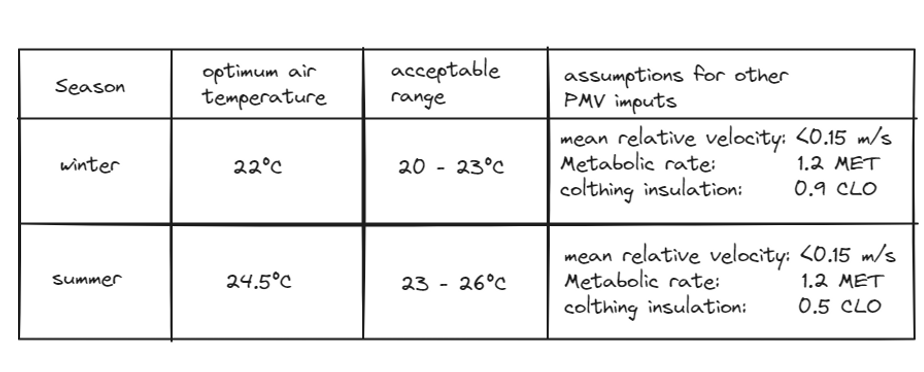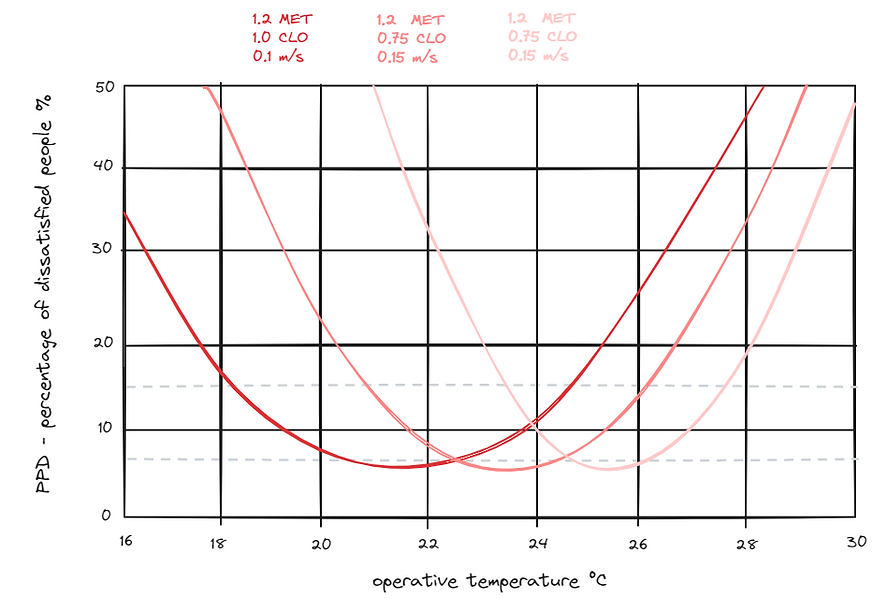
thermal comfort
Thermal comfort can be divided in two areas:
1. Human perception
2. Physical factors of influence
1. Human perception
Before we get into the discussion of thermal comfort and what it means, we need to understand a few basic terms and concepts. First and foremost, the connection between our clothing and metabolic rate (activity). Based on what we wear and what we do at any given moment the optimal room air temperature would be different for most of us. Those factors are related to as [clo] for clothing and [met] for metabolic rate. For example, while exercising we tend to wear less because our body produces excess heat and must get rid of it. But if we were to read a book in the fitness center sitting in a chair for hours, in all likelyhood we would dress differently. Most adjust their clothing without thinking about it. But it is very fundamental to understand, that the clothing is our first layer of insulation or protection against the cold. Thus, it makes sense to remove most of it in summertime or add when we start to feel cold in the fall.

A «comfortable climate» or a «comfortable temperature» for this matter, is very subjective to all of us. Countless studies have been made on the subject of 'human comfort level' and yet it remains a field of research. But the study of Paul Ole Fanger, done in 1972 is arguably one of the most important ones. Fanger created a scale, that would start at 0 (neutral) and deviate as far as +3 for too hot and -3 for too cold. But without setting a temperature to the scale. He then asked all his participants of the study to tick the fitting box according to how they felt at any given room air temperature. Needless to say, adjustments of clothing or any other parameters were not allowed. What he found is, regardless of the temperature the participants never agreed 100%. Or in other words if we assume those who voted anything other than neutral were slightly dissatisfied, we could conclude, that there will always be at least 5% that remain unsatisfied to some degree. In practice that number tends to be at a higher level and usually fluctuates around 10-15%. This is what represents the PPD Index. That minimum PPD Index became his «neutral». The PPD percentage shows us the expected percentage of dissatisfied people when deviating away from neural to either side.

As thermal comfort remains subjective to all of us and with the knowledge from above however, it makes sense to think of a temperature range rather than a specific number. If we take a temperature range from "slightly cool at -1" to "slightly warm at +1" we would set a base for the thermal comfort where about 90% of the participants would feel ok with. A difference we can all make up by adjusting our clothing. This phenomenon can be observed on a plane for example. While some are sitting in there wearing a T-shirt, others are putting on a pullover already. Of course, an airplane is a bit of a different story altogether and the comparison would not uphold academic standards. But for the sake of this explanation, everyone gets the picture. Some may be doing this at home as well instead of adjusting the heating.

Now if we had to put that into a document that would standardize the «optimal» temperature at a specific number we would choose the temperature where the least amount of people was disssatisfied or where the most percentage of participants agreed on. But we have to keep in mind, participants were not allowed to adjust their clothing. Imagine what kind of discussions we would find in an airplane. In other words, if we aim for a range of 20 – 23°C in wintertime we have a perfect base to make ourselves comfortable through the adjustment of clothing. That is the goal of SHB-Hosues. We aim for a minimal indoor air temperature of 20-21°C at the lowest outside air temperature.

2. Physical factors of influence
What other factors take an influence on our thermal comfort? Well, as we all know from the weather forecast, there is a difference between the measured temperature and what we, humans perceive. In weather forecasts it is often referred to as the “wind chill factor”. Similar to that there are mainly two factors that influence our thermal comfort in a building.
A) Velocity of airflow similar to the windchill factor and
B) Local thermal discomfort factor
(caused by the temperature radiation of the surrounding surfaces)
If a building suffers from either or both of those the only way to solve the issue would be to increase the indoor room temperature. Now it becomes obvious why SHB-Houses pays a lot of attention to such details during the planning process, to keep those effects at a minimum.
A) Windchill factor
In almost every building we can detect some movement of indoor air partially due to air leaks, also known as infiltration. Some rooms are more vulnerable to this phenomenon than others. For example, if the kitchen exhaust is solved traditionally, there has to be a connection with the outside. Whenever the ventilation is running it removes air from the kitchen and transports it to the outside. That also means supply air needs to be coming in from somewhere to restore the pressure. Usually, the air finds its way in on the weakest point of the building envelope, wherever that is. While the kitchen ventilation is running, it will create an airflow from that point all the way into the kitchen. Of course, there is other ways around this specific “kitchen exhaust” problem. However, it is obviously very difficult to build a house without infiltration at all because windows, doors and other components will always have some sort of leakage. Generally speaking, expensive components that have a higher quality standard tend to be better in that regard.
B) Local thermal discomfort factor
The higher the temperature difference between the room air temperature at the tip of our nose and the surface temperature (also known as operative temperature) our nose is facing, the higher the influence of this factor becomes. That is getting complex quickly, as our nose is facing a couple of surfaces at the same time. Ceiling, floor and probably at least three other walls. However, without getting to much into the detail the distance to those surfaces also matters. Back in the days there were recommendations in place for maintaining distances to exterior and interior walls. Meaning, that the residents of a building should maintain a distance of i.e. 1,5 meters to a window, 1m to an exterior wall and so on before placing any furniture. Imagine how much space one would lose if we still had to do that. In a standard insuated Portugese house however, it is recommended to do exactely that and maintain those distances, because the operative temperatures tend to drop significantly. But how do we make sure this factor is reduced to a minimum? Well simply by reducing the temperature difference between surfaces and room air temperature. The best case obviously, would be no difference at all. So, the question is, how do we achieve higher operative temperatures then? The simplified answer is by enhancing the insulation standard.
To resume, the insulation is responsible for the following:
- how much energy a building loses during wintertime
- the reduction of local thermal discomfort factor
- how much of the indoor area is actually usuable within the range of
our thermal comfort
Would you have guessed that?


